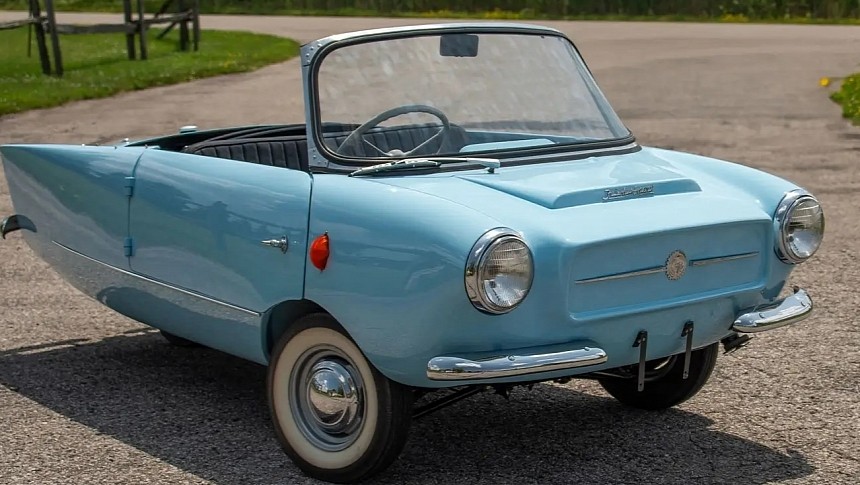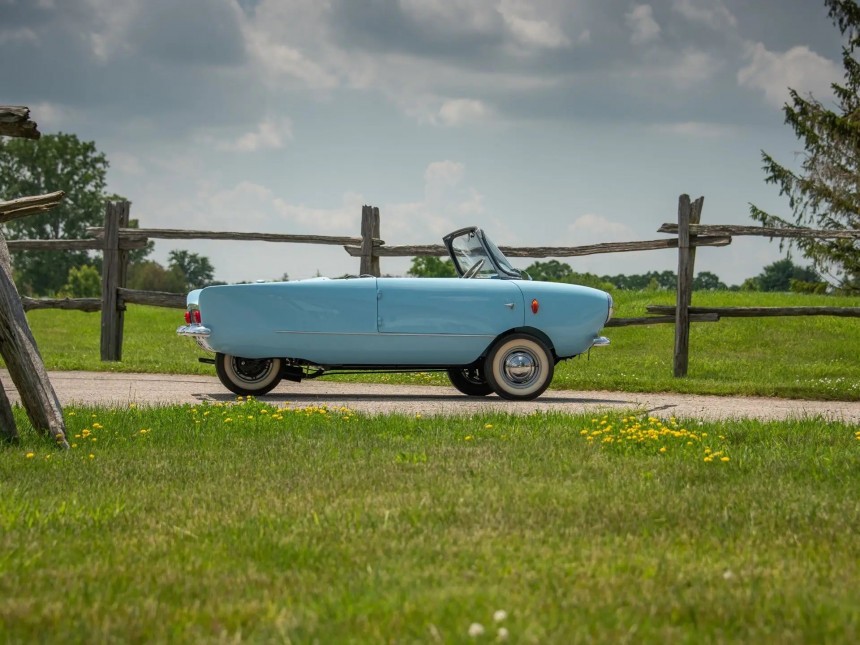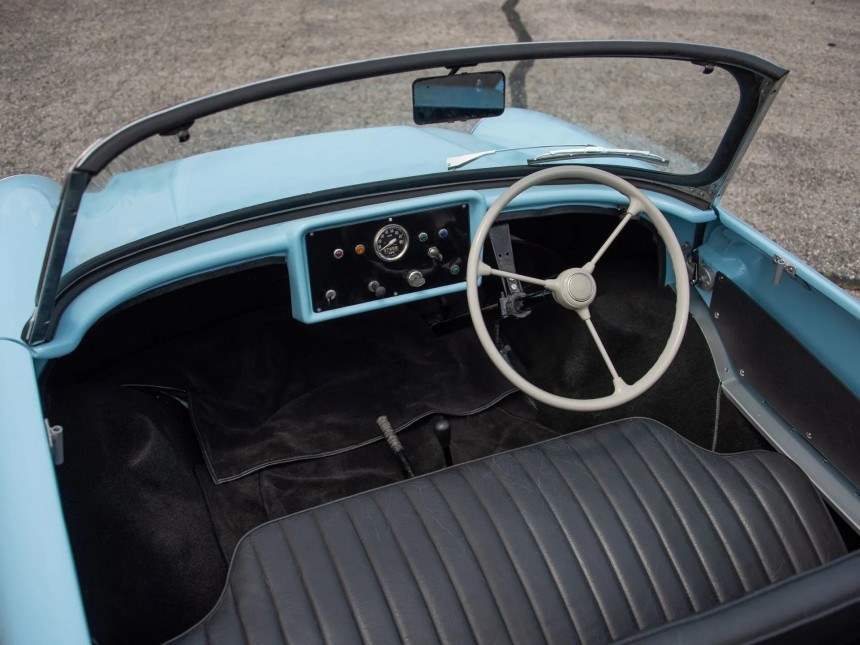Nowadays, microcars are increasingly gaining popularity in many parts of the world as an alternative solution to solve pollution and traffic problems in large cities and to create a greener future for urban driving. However, back in the 1950s and 60s, when the economy was still recovering after World War Two, microcar production was seen as a way to bring affordable transportation within the reach of more European families.
The most popular small vehicles produced in that period came from brands like BMW (everybody knows the Isetta microcar), Bond, Heinkel/Trojan, and Goggomobil, but there were other less-known car companies that saw microcar manufacture as a market worth entering. One such company was Frisky Cars, earlier known as Meadows Frisky, which produced several different microcar models - some with four wheels and others with three wheels - between 1958 and 1961.
The car in the gallery above started life as a Frisky Family Tree, which was the first three-wheeled model produced by the company, and was transformed into a convertible under previous ownership. The modification gained the car one-off status, as it is the only convertible Frisky Family Tree in the world, considering the manufacturer never offered a convertible version of this particular model.
Frisky microcars are a rare breed in general, as only approximately 1,500 were built in total, and just 75 examples are believed to still be in existence today.
The origins of the Frisky Cars (very nearly called Phoenix) can be traced back to Cairo, Egypt, in the mid-1950s, when a British businessman and avid racing driver named Captain Raymond Flower came up with the idea of building affordable, lightweight automobiles locally for the Egyptian people. The Suez Crisis of 1956 put an end to Flower's ambitions, and the man moved back to England and took his plans along with him.
He approached Henry Meadows (Vehicles) Ltd based in Wolverhampton with his microcar concept, and that's how the first prototype - known as The Bug - came to be.
Many microcars developed in the post-WW2 era were designed as simple, practical machines for the masses with little focus on style or comfort, but some of these small cars happen to be more pleasing to the eye and really well-engineered. This was also the case with The Bug and its successors.
The new microcar boasted radical styling with a fiberglass body with gullwing doors. It was built on a brazed steel ladder chassis and had four wheels and two seats. It was powered by a Villiers air-cooled 250cc twin-cylinder motorcycle engine, which sent power to the rear wheels via chain drive. The vehicle performed pretty well at the initial trials carried out at the Oulton Park circuit, which led to it being described as "a frisky little car," hence its subsequent name.
The eventual production car was designed by none other than Giovanni Michelotti and built by Carrozzeria Vignale of Turin, Italy, who had previously worked on Ferraris and Maseratis, such as the beautiful Ferrari 225 Sport. The "frisky" microcar was introduced to the market as Meadows Frisky Sport, a quite appropriate name for its lively performance. It didn't feature gullwing doors, as they were deemed impractical and made production too expensive, but the car still boasted a delightful styling and was said to be capable of reaching 65 mph (105 kph), an excellent performance by the microcar standards of the time.
Whilst the early four-wheeled models proved popular with the masses, there was a larger market for a three-wheeled version, so in 1959, the company introduced the Frisky Family Three. The new microcar preserved the Sport's styling but featured a new hard top body and was powered by a single-cylinder, 197-cubic-centimeter Villiers engine with four speeds and reverse. The Family Three sold very well, appealing to those who held motorbike licenses due to its three-wheeled design.
A Family Three Mk2 version would go into production in 1960, while another model named Prince was the last Michelotti design to carry the Frisky name.
The 1959 Frisky Convertible Special you see here is based on a three-wheeled Family Three coupe that was skillfully transformed into a convertible. It's a unique car and represents an intriguing "what if," showing what a Frisky Family Three Convertible would have looked like if the company had ever developed one.
It's a cute little car with a charming appearance highlighted by the cheerful sky-blue exterior. At the front, it boasts a "FriskySport" badge borrowed from an earlier four-wheeled convertible. The no-frills black interior offers seating for two and has the steering wheel on the right, plus a simple dashboard in the center. Under the hood sits a 197cc two-stroke, single-cylinder Villiers engine.
This one-of-a-kind Frisky Family Three is now looking for a new owner. It's set to go under the hammer with RM Sotheby's in mid-August, with a price guide of $30,000 – $40,000. The fact that Frisky microcars are rarer than hen's teeth, coupled with their adorable and cartoonish appearance, only increases their appeal among enthusiasts and collectors, and they are known to garner a terrific reaction from people whenever they make an appearance at car shows.
The car in the gallery above started life as a Frisky Family Tree, which was the first three-wheeled model produced by the company, and was transformed into a convertible under previous ownership. The modification gained the car one-off status, as it is the only convertible Frisky Family Tree in the world, considering the manufacturer never offered a convertible version of this particular model.
Frisky microcars are a rare breed in general, as only approximately 1,500 were built in total, and just 75 examples are believed to still be in existence today.
He approached Henry Meadows (Vehicles) Ltd based in Wolverhampton with his microcar concept, and that's how the first prototype - known as The Bug - came to be.
Many microcars developed in the post-WW2 era were designed as simple, practical machines for the masses with little focus on style or comfort, but some of these small cars happen to be more pleasing to the eye and really well-engineered. This was also the case with The Bug and its successors.
The new microcar boasted radical styling with a fiberglass body with gullwing doors. It was built on a brazed steel ladder chassis and had four wheels and two seats. It was powered by a Villiers air-cooled 250cc twin-cylinder motorcycle engine, which sent power to the rear wheels via chain drive. The vehicle performed pretty well at the initial trials carried out at the Oulton Park circuit, which led to it being described as "a frisky little car," hence its subsequent name.
The eventual production car was designed by none other than Giovanni Michelotti and built by Carrozzeria Vignale of Turin, Italy, who had previously worked on Ferraris and Maseratis, such as the beautiful Ferrari 225 Sport. The "frisky" microcar was introduced to the market as Meadows Frisky Sport, a quite appropriate name for its lively performance. It didn't feature gullwing doors, as they were deemed impractical and made production too expensive, but the car still boasted a delightful styling and was said to be capable of reaching 65 mph (105 kph), an excellent performance by the microcar standards of the time.
A Family Three Mk2 version would go into production in 1960, while another model named Prince was the last Michelotti design to carry the Frisky name.
The 1959 Frisky Convertible Special you see here is based on a three-wheeled Family Three coupe that was skillfully transformed into a convertible. It's a unique car and represents an intriguing "what if," showing what a Frisky Family Three Convertible would have looked like if the company had ever developed one.
It's a cute little car with a charming appearance highlighted by the cheerful sky-blue exterior. At the front, it boasts a "FriskySport" badge borrowed from an earlier four-wheeled convertible. The no-frills black interior offers seating for two and has the steering wheel on the right, plus a simple dashboard in the center. Under the hood sits a 197cc two-stroke, single-cylinder Villiers engine.
This one-of-a-kind Frisky Family Three is now looking for a new owner. It's set to go under the hammer with RM Sotheby's in mid-August, with a price guide of $30,000 – $40,000. The fact that Frisky microcars are rarer than hen's teeth, coupled with their adorable and cartoonish appearance, only increases their appeal among enthusiasts and collectors, and they are known to garner a terrific reaction from people whenever they make an appearance at car shows.



















